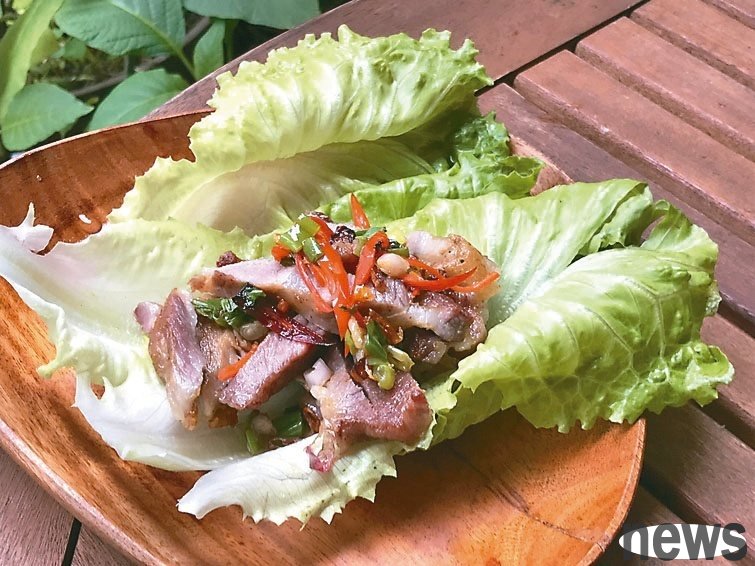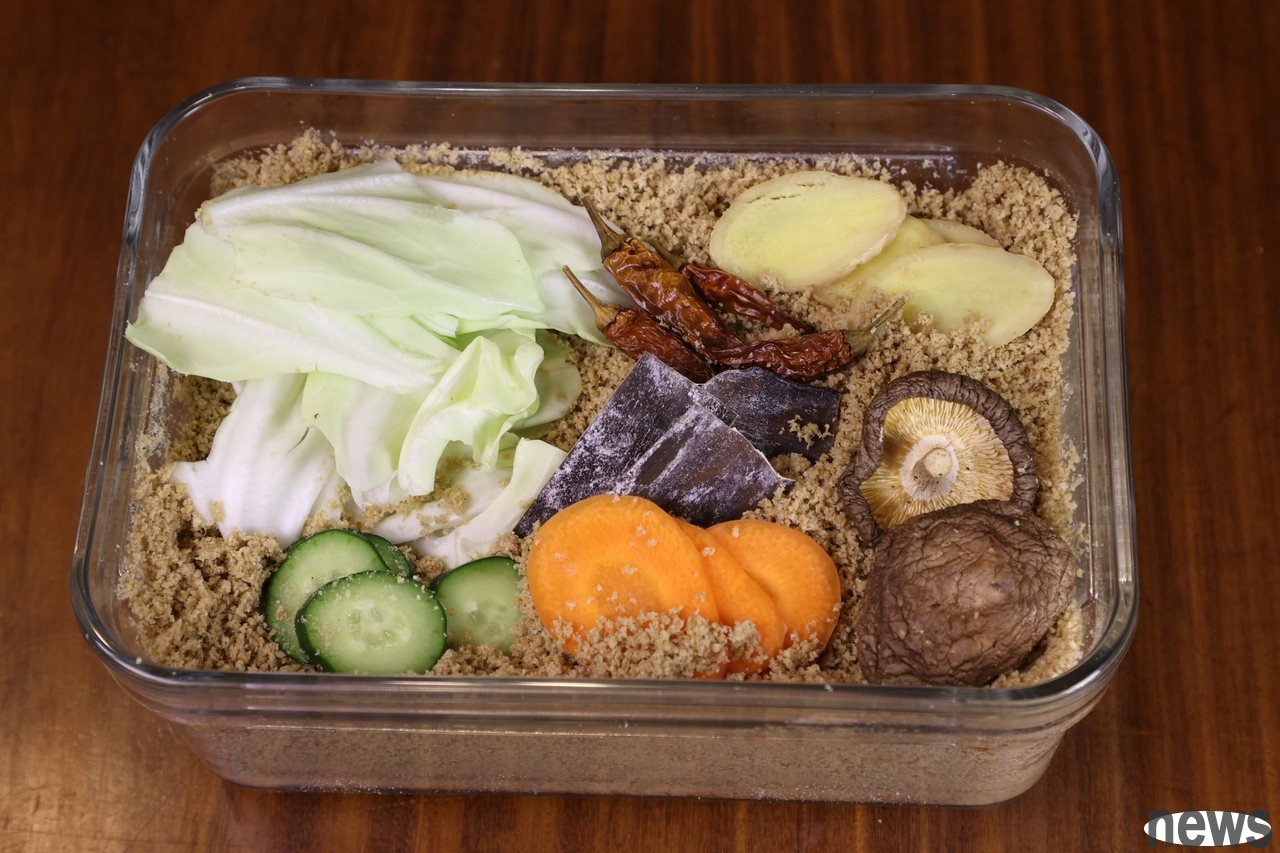
It is the rice harvest season again, and it is time to make "rice bran rinds". It is relatively easy to obtain "rice bran". It is the "waste food" after grinding rice and is also the most nutritious part of rice. It is generally made into fertilizer or feed. By chance, I learned about "rice bran stew" from Sister Liu. When I checked "Rice Bran" and happened to "cut off" Jessical LIn bought the newly published "Rice Bran - Teaching Book" from Japan. If I don’t understand, I also asked the Meihong point of life in Japan and Yilan’s slow islands to be miserable. I will increase my skills and fully open my firepower to cultivate the “rice bran bed” needed to cultivate rice bran.
"Rice bran rind" and marinated sauerkraut have similar principles. They are both fermented by lactic acid bacteria, and the difference is the difference in the "median", one is water and the other is rice bran. The rice bran bed is made of rice bran and salt water (inhibiting bacteria), and then added vegetables to attract microorganisms such as lactic acid bacteria. The side ingredients added at the same time, such as mushrooms, seaweed, ginger, honey, pepper, ginger, etc., not only add the freshness of the rice bran bed, but also inhibit the growth of bacteria, allowing lactic acid bacteria to reproduce in the "optimal environment". After a few days, a "rice bran bed" containing a large number of lactic acid bacteria and other bacterial groups is cultivated, and then "bury" the ingredients to be marinated (vegetables, fish, and meat). The fermented substance (sauce) is rice bran.
The ingredients that each person feeds are different from the region and environment (the flora will be different), and the difference in personal "methods", creating unique flavors and can also be used as treasures for the family. According to the "rice bran bed" that Japan has been raising for more than two hundred years, it is one of the must-have weddings in Japan in the early days. It can be seen that rice bran has a profound meaning in Japanese food culture. But if you don't take good care of it, you will have a terrible "stinky scent".

Architecture:
【Rice bran beds】
Rice bran: Water: Salt=10:8:1.3 (about 13% of rice bran)
Rice bran: 1000g
Water: 800g
Salt: 130g
【Ingredients】
Vegetables: glutinous vegetables, eggplant, glutinous rice, cucumber, glutinous rice or leaf vegetables, glutinous rice, glutinous rice or leaf vegetables, glutinous rice, glutinous rice, glutinous rice, glutinous rice, glutinous rice, glutinous rice, glutinous rice, eggplant, glutinous rice, glutinous rice, glutinous rice, glutinous rice, glutinous rice, glutinous rice, glutinous rice, glutinous rice, glutinous rice, glutinous rice, glutinous rice, glutinous rice, glutinous rice, glutinous rice, glutinous rice, glutinous rice, glutinous rice, glutinous rice, glutinous rice, glutinous rice, glutinous rice, glutinous rice, glutinous rice, glutinous rice, glutinous rice, glutinous rice, glutinous rice, glutinous rice, glutinous rice, glutinous rice, glutinous rice, glutinous rice, glutinous rice, glutinous rice, glutinous rice, glutinous rice, glutinous rice, glutinous rice, glutinous rice, glutinous rice, glutinous rice, glutinous rice, glutinous rice, glutinous rice, glutinous rice, glutinous rice, glutinous rice, glutinous rice, glutinous rice, glutinous rice, glutinous rice, glutinous rice, glutinous rice, glutinous rice, glutinous rice, glutinous rice, glutinous rice, glutinous rice, glutinous rice, glutinous rice, glutinous rice, glutinous rice, glutinous rice, glutinous rice, glutinous rice,
Size: After decorating all ingredients, leave half of the space for future refills.
【Temperature】The temperature placed in
is generally suitable for the room temperature (between about 20~30℃). If the temperature is too low, the lactic acid bacteria will reduce growth and can also be stored at low temperatures. If you don't need it for a long time, you can refrigerate it in the refrigerator, or even cool it to make the lactic acid bacteria dormant.
Method:
1. Fry the rice bran slowly under low heat, and it will have a slight fragrance when it is warm. It can remove some bacteria, reduce moisture content, and increase the aroma of rice bran.
2. Dissolve the salt in water, mix the rice bran, and mix it into a base rice bran bed.
3. Cut the ingredients into small slices.
4. Disperse the ingredients separately, bury them into the rice bran bed, and pressure the rice bran bed to discharge air, which is conducive to the growth of oxygen-induced lactic acid bacteria and inhibit (aerobic) bacteria.
5. After pressure, clean the rice bran on the walls around the container to avoid breeding bacteria.
6. Add a lid and place it in the radius (about 25℃).
7. Turn the rice bran bed thoroughly every day, and after turning, it should be pressed and scraped and left the rice bran on the container wall.
8. When turning, also hear the changes in the smell. After three or four days, you can try to see if the rice bran has a sour fragrance.
9. It has a sour taste, no unsuitable taste or stinky scent, which means that the rice bran bed has succeeded.
TIPS
● Choose a suitable rice bran bed with the amount of marinated rice bran (sauce).
● When filling the pressure, press hard to discharge air. If there is air left, it may cause bacteria to grow and affect the fermentation of lactic acid bacteria.
Start making rice bran (Japanese sauce)After raising the "rice bran bed", you can start marinating. Meat in the morning and can be eaten at night; or eat it in the evening or in the morning. Serve with the porridge, and eat with the hot porridge, and serve with "sauce", which makes it taste good. Eating the sauce you cooked yourself will get rid of the delicious taste and add a sense of accomplishment.
"Rice Bran Bed" will be as delicious as it is, with a light wine and a sour aroma of multiple levels. After turning, the fragrance of the "rice bran bed" in my hand will not dissipate for a long time. The taste is amazing and it has the flavor of Japanese marinated sauce (rice bran).
Peach any vegetables during the season. Fish and meat you can eat can also be used, but they need to be dried. Rice bran relies on the lactic acid bacteria on the "bed" to ferment the ingredients, bringing out the unique sour and fragrant taste of each ingredient, and at the same time bringing the flavour of the rice bran bed and the unique flavor brought by adding side ingredients. The ingredients and side dishes added are different from the techniques, creating a rice bran bed with different flavors. The sauces produced are all unique in their own flavor.
Cure vegetablesIngredients: White stew, pine nut, eggplant, cucumber, red pepper, yellow pepper, baby cabbage
Cooking:
1. Cut eggplant and cucumber straight into the crust to facilitate taste and beauty, and then cut into sections.
2. Sprinkle 1~2% of the salt of Komatsu vegetable and remove the excess water after a few minutes..
3. Cut the sausage into strips, cut the cabbage into half, cut the red pepper and yellow pepper into four parts, or cut them into eight parts.
4. Spread the prepared vegetables completely "buried" into the rice bran bed. Press and scrape off the rice bran from the container wall.
5. Stabilize the static space for about 8 to 12 hours.
6. "Dig" out the marinated vegetables, cut them into small pieces or slices and eat them.
TIPS
● Some vegetables have more water, or have a green smell. Use salt to kill the green and remove water before marinating. You can also blanch and reduce the green flavor to avoid the bitter taste of the sauce.
● If the curing time is too long (more than 24 hours) you will be too scattered and more acidic. You can soak the sausage in water, reduce the salt content before eating, or cut into pieces or chop them into powder to serve as a condiment when cooking.
Medical and rinse foodIngredients: Fish slices, pork slices
Meat:
1. Sprinkle some salt on the fish and meat, and then suck out the excess water with a paper towel.
2. Completely "buried" the rice bran bed. Pressure and scrape and leave rice bran on the container wall. (Add a rice bran bed, do not share it with marinated vegetables.)
3. You can "dig" out marinated fish and meat in about one day or more.
4. The fish and meat that are well-cured should be cooked (fried, cooked) before eating.
Maintenance of rice bran bedAfter the rice bran bed is cured many times, it will slowly become moisturized and adversely affect the growth of lactic acid bacteria, and the "repairing bed" can remove excess moisture, adjust the salt content appropriately and add the "bed" flavor. If it is not cured for a long time, proper preservation can extend the "life" of the rice bran bed.
● Add fried rice bran to directly reduce the moisture content. You can also use yellow beans, wash them in water and stir-fry them over low heat until the surface of the snail disappears. Stir in the rice bran bed to absorb moisture.
Give the taste of the rice bran bed, and the sauce is not scattered or the sauce is not scattered, and then add appropriate amount of salt water to adjust. You can add side dishes such as chenpi, kumbu, mushrooms, honey, dry grapefruit peel, apple peel, etc., which can increase the aroma and unique flavor of the rice bran bed, and can also absorb more moisture.
● The rice bran bed that is not properly cared for breeding bacteria and smelly stinky odor. First remove most of the rice bran bed, then mix in an equal amount or more basic materials of the rice bran bed (rice bran: water: salt = 10:8:1.3), mix and mix, add vegetables, side ingredients, etc. to continue to nourish, which is faster than the new rice bran bed.
● After the bed is expanded, the amount of rice bran bed is reduced, or the amount of rice bran beds needs to be added to "separate beds" to cure food (fish, meat). Add the basic materials of the rice bran bed (rice bran: water: salt = 10:8:1.3) to increase, too much salt can reduce the proportion of salt.
● Save
If you do not use it for a short time, store it in the refrigerator to let the fungus "dormant". You don’t need to put the chiller in a long time, it can be kept for about half a year. It is also OK to not put the refrigerator. Put a layer of salt on it, completely cover the surface of the rice bran bed, and store it in a cool place. This is how it is stored without a refrigerator. When used, scrape off the salt on the surface and the rice bran bed on the surface. If it is still too hot, you can add rice bran and water directly to reduce the salt content.
Fungal KnowledgeThere are various fungi on the rice bran bed, mainly three types of "lactic acid bacteria", "film yeast" and "stacic acid bacteria".
lactic acid bacteria of oxidation are the main bacteria that produce unique flavors of rice bran; the surface of yeast is aerobic bacteria, which produces a white film on the surface; and the oxidase bacteria on the base are also oxidation bacteria, which has a "stinky odor" that it grows too well. Turning the rice bran bed every day is to inhibit the growth of aerobic membrane yeast and oxygen-induced sarcotic acid bacteria, allowing lactic acid bacteria to grow in a large amount in the advantageous environment and become the main bacterial group.
Next:The nutritious and abundant "ABC juice" can even be eaten before breakfast to remove internal fat! One more step before making juice can increase nutrient absorption